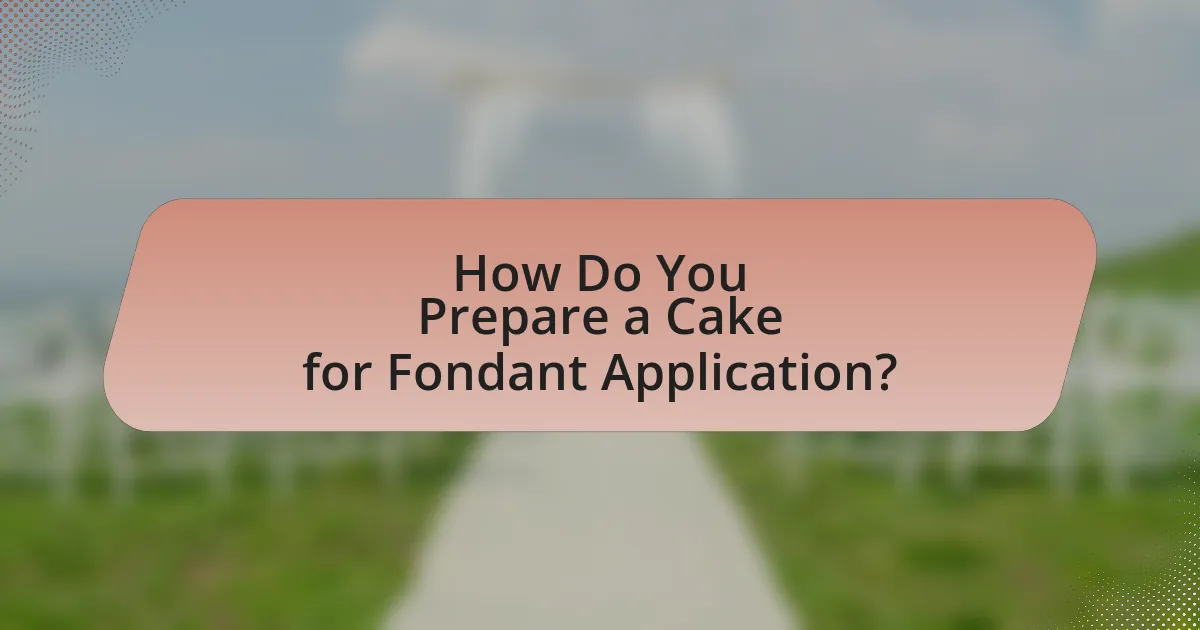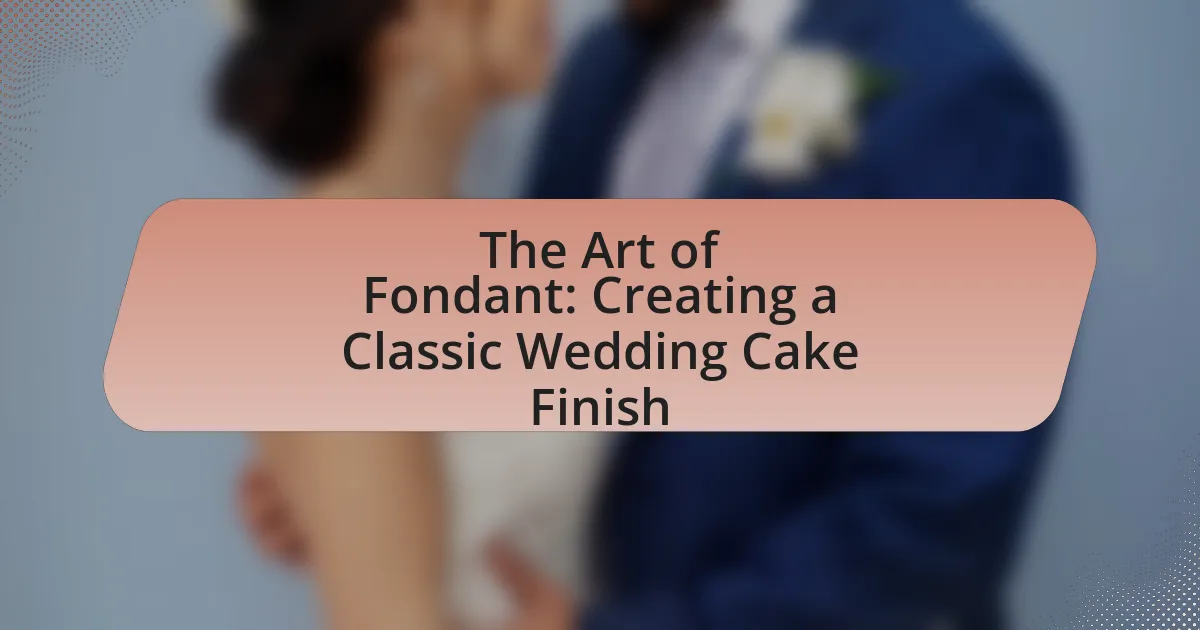Fondant is a smooth, pliable icing made from sugar, water, and gelatin, widely used to cover and decorate wedding cakes due to its ability to create a polished finish and intricate designs. This article explores the characteristics of fondant, its advantages over other cake finishes, and the various types available, including rolled and poured fondant. It also details essential tools and ingredients for working with fondant, preparation techniques for cakes, and best practices for achieving a flawless finish. Additionally, the article addresses common mistakes to avoid and troubleshooting tips to ensure successful fondant application, enhancing the overall aesthetic of wedding cakes.

What is Fondant and Its Role in Wedding Cakes?
Fondant is a smooth, pliable icing made primarily from sugar, water, and gelatin, used to cover and decorate cakes, particularly wedding cakes. Its role in wedding cakes is significant as it provides a sleek, polished finish that enhances the cake’s aesthetic appeal, allowing for intricate designs and decorations that are not achievable with traditional buttercream. Fondant also acts as a protective layer, helping to seal in moisture and maintain the cake’s freshness. The versatility of fondant enables cake designers to create elaborate shapes and figures, making it a popular choice for custom wedding cake designs.
How is Fondant Different from Other Cake Finishes?
Fondant is different from other cake finishes primarily due to its smooth, pliable texture that allows for intricate designs and a polished appearance. Unlike buttercream or ganache, which can be more textured and less stable for detailed decorations, fondant provides a uniform surface that can be molded and shaped easily. This characteristic makes fondant particularly suitable for creating elaborate decorations, such as flowers and figurines, which are often desired in wedding cakes. Additionally, fondant can be rolled out to cover cakes completely, giving them a sleek look that is difficult to achieve with other finishes.
What are the key characteristics of Fondant?
Fondant is a smooth, pliable icing made primarily from sugar, water, and gelatin, which allows it to be rolled out and draped over cakes for a polished finish. Its key characteristics include a soft texture that becomes firm upon drying, a sweet flavor that can be flavored or colored, and the ability to create intricate designs and decorations. Fondant’s versatility makes it suitable for various cake styles, particularly in wedding cakes, where it provides a sleek, elegant appearance. Additionally, it can be molded into shapes, allowing for creative embellishments that enhance the overall aesthetic of the cake.
Why is Fondant preferred for wedding cakes?
Fondant is preferred for wedding cakes because it provides a smooth, elegant finish that enhances the cake’s aesthetic appeal. This sugar-based icing can be molded into intricate designs and shapes, allowing for greater creativity in decoration compared to traditional buttercream. Additionally, fondant creates a protective layer that helps retain moisture in the cake, ensuring it remains fresh for longer periods, which is particularly important for multi-tiered wedding cakes. The versatility of fondant also allows for a wide range of flavors and colors, making it suitable for various wedding themes and preferences.
What Types of Fondant are Available?
There are several types of fondant available, including rolled fondant, poured fondant, and modeling chocolate. Rolled fondant is the most commonly used type for covering cakes, as it provides a smooth finish and can be easily colored and shaped. Poured fondant is typically used for glazing pastries and creating a shiny finish, while modeling chocolate is a pliable mixture of chocolate and corn syrup that can be molded into intricate designs. Each type serves different purposes in cake decoration, allowing for versatility in presentation and design.
What are the differences between rolled fondant and poured fondant?
Rolled fondant and poured fondant differ primarily in their texture and application methods. Rolled fondant is a pliable dough-like substance that can be rolled out and draped over cakes, providing a smooth, polished finish. In contrast, poured fondant is a liquid mixture that is poured over cakes or confections, creating a glossy coating. Rolled fondant typically contains sugar, water, gelatin, and glycerin, while poured fondant is made from sugar, water, and corn syrup, resulting in a thicker consistency. These differences in composition and application lead to distinct visual and textural outcomes on baked goods.
How do different types of fondant affect the cake’s texture and taste?
Different types of fondant significantly influence a cake’s texture and taste. Rolled fondant, known for its smooth finish, creates a firm texture that can be somewhat chewy, while its flavor is often described as sweet but can be bland compared to other options. In contrast, poured fondant offers a glossy, softer texture that enhances moisture retention in the cake, resulting in a more tender bite, though it may also be overly sweet for some palates. Additionally, chocolate fondant introduces a richer flavor profile and a denser texture, which can complement various cake types, enhancing both taste and mouthfeel. These variations in fondant types directly impact the overall sensory experience of the cake, making the choice of fondant crucial for achieving the desired outcome in texture and flavor.
What Tools and Ingredients are Needed for Working with Fondant?
To work with fondant, essential tools and ingredients include fondant itself, a rolling pin, a smooth surface for rolling, cornstarch or powdered sugar for dusting, a sharp knife or pizza cutter for cutting, and food-safe brushes for applying color or water. Additionally, a fondant smoother helps achieve a polished finish, while modeling tools assist in creating intricate designs. These items are crucial for effectively handling and shaping fondant, ensuring a professional appearance on cakes.
What essential tools should every fondant decorator have?
Every fondant decorator should have a rolling pin, fondant smoother, and a set of fondant tools. A rolling pin is essential for evenly rolling out fondant to the desired thickness, while a fondant smoother helps achieve a flawless finish on cakes by eliminating air bubbles and creases. Additionally, a set of fondant tools, including cutters, molds, and sculpting tools, allows decorators to create intricate designs and details, enhancing the overall appearance of the cake. These tools are fundamental for achieving professional results in fondant decoration.
Which ingredients are crucial for making homemade fondant?
The crucial ingredients for making homemade fondant are powdered sugar, gelatin, water, glycerin, and corn syrup. Powdered sugar provides the primary structure and sweetness, while gelatin acts as a stabilizer, giving the fondant its pliable texture. Water is necessary to dissolve the gelatin, and glycerin adds moisture and flexibility. Corn syrup contributes to the smoothness and helps prevent crystallization. These ingredients work together to create a smooth, moldable fondant suitable for cake decoration.

How Do You Prepare a Cake for Fondant Application?
To prepare a cake for fondant application, first ensure the cake is completely cooled and level. A cooled cake prevents melting or deforming the fondant, while leveling creates a smooth surface for even coverage. Next, apply a layer of buttercream or ganache to seal in moisture and create a smooth base for the fondant. This layer should be approximately 1/4 inch thick, as it helps the fondant adhere properly and provides a barrier against moisture. Finally, chill the cake for about 30 minutes to set the buttercream or ganache, making it easier to roll out and apply the fondant smoothly. This method is widely used by professional bakers to achieve a polished finish on wedding cakes.
What Steps are Involved in Preparing the Cake?
To prepare a cake, the steps involved include gathering ingredients, mixing the batter, baking, cooling, and leveling the cake layers. First, gather essential ingredients such as flour, sugar, eggs, butter, and baking powder. Next, mix the ingredients in a specific order, typically starting with creaming butter and sugar, followed by adding eggs and dry ingredients. After mixing, pour the batter into prepared cake pans and bake at the appropriate temperature, usually around 350°F (175°C), for a specified time until a toothpick inserted comes out clean. Once baked, allow the cakes to cool completely before leveling the tops to ensure even stacking. These steps are fundamental in cake preparation, ensuring a well-structured and delicious final product.
How do you ensure a smooth surface for fondant application?
To ensure a smooth surface for fondant application, start by leveling and crumb-coating the cake with a thin layer of buttercream or ganache. This layer acts as a barrier, sealing in crumbs and providing a smooth base for the fondant. The buttercream should be applied evenly and smoothed out using a spatula or a bench scraper. Additionally, chilling the cake for about 30 minutes after applying the crumb coat helps to firm it up, making it easier to achieve a flawless finish when rolling out and applying the fondant. This method is widely used by professional bakers to create a polished look on wedding cakes.
What role does frosting play in fondant application?
Frosting serves as a crucial adhesive layer in fondant application, ensuring that the fondant adheres smoothly to the cake surface. This layer not only helps to create a seamless finish but also provides a barrier that prevents the cake from drying out. A common practice is to use a buttercream or ganache frosting, which, when applied evenly, allows the fondant to glide over the cake without slipping or tearing. The effectiveness of frosting in this role is supported by the fact that a well-frosted cake can significantly enhance the overall appearance and texture of the fondant, leading to a more polished and professional look.
How Do You Properly Cover a Cake with Fondant?
To properly cover a cake with fondant, first ensure the cake is completely cooled and has a smooth surface, ideally with a layer of buttercream or ganache to help the fondant adhere. Roll out the fondant to about 1/8 inch thick, ensuring it is large enough to cover the entire cake. Carefully lift the rolled fondant using a rolling pin and drape it over the cake, smoothing it down with your hands or a fondant smoother to eliminate air bubbles and wrinkles. Trim any excess fondant at the base of the cake for a clean finish. This method is effective because a smooth surface and proper application techniques prevent cracking and ensure a professional appearance.
What techniques can be used to roll out fondant evenly?
To roll out fondant evenly, use a combination of a rolling pin, a smooth surface, and consistent pressure. Start by dusting the work surface with cornstarch or powdered sugar to prevent sticking. Then, place the fondant in the center and flatten it slightly with your hands. Using a rolling pin, apply even pressure while rolling from the center outward, rotating the fondant periodically to maintain a circular shape. This technique ensures uniform thickness. Additionally, using guides such as rolling pin rings can help achieve a consistent thickness throughout the fondant.
How do you avoid common mistakes when covering a cake with fondant?
To avoid common mistakes when covering a cake with fondant, ensure the cake is properly chilled and has a smooth, crumb coat applied. A chilled cake helps the fondant adhere better and reduces the risk of tearing. Additionally, using a rolling pin to evenly roll out the fondant to the correct thickness prevents it from being too thick or too thin, which can lead to issues during application. Properly dusting the work surface with cornstarch or powdered sugar prevents sticking, allowing for easier handling. Finally, using a fondant smoother helps eliminate air bubbles and creates a polished finish. These techniques are widely recommended by professional bakers and cake decorators to achieve a flawless fondant-covered cake.

What Are the Best Practices for Decorating with Fondant?
The best practices for decorating with fondant include ensuring a smooth surface on the cake, using cornstarch or powdered sugar to prevent sticking, and rolling the fondant to an even thickness of about 1/8 inch. A smooth cake surface is crucial because it prevents imperfections from showing through the fondant, which can be achieved by applying a layer of buttercream or ganache before covering with fondant. Using cornstarch or powdered sugar helps to keep the fondant from adhering to surfaces, allowing for easier handling and shaping. Rolling the fondant to a consistent thickness ensures even coverage and a professional appearance. These practices are supported by expert bakers who emphasize the importance of preparation and technique in achieving a polished finish on fondant-decorated cakes.
How Can You Create Decorative Elements with Fondant?
To create decorative elements with fondant, roll out the fondant to the desired thickness and use various tools such as cutters, molds, and sculpting tools to shape it into specific designs. For instance, using a flower cutter can produce floral shapes, while molds can create intricate patterns or figures. Additionally, applying edible colors or dusts can enhance the visual appeal of the fondant decorations. This method is widely used in cake decorating, as fondant allows for versatile and detailed designs that can elevate the overall aesthetic of cakes, particularly in wedding cake presentations.
What tools are best for cutting and shaping fondant decorations?
The best tools for cutting and shaping fondant decorations include fondant cutters, rolling pins, and modeling tools. Fondant cutters, such as cookie cutters or specialized fondant shapes, allow for precise cutting of various designs. Rolling pins, particularly those with guides, help achieve an even thickness for the fondant, which is essential for uniform decorations. Modeling tools, including ball tools and spatulas, assist in shaping and detailing fondant, enabling intricate designs. These tools are widely recognized in cake decorating and are essential for achieving professional-quality fondant decorations.
How do you achieve realistic textures and details with fondant?
To achieve realistic textures and details with fondant, use tools like fondant smoothers, texture mats, and modeling tools to create intricate designs. These tools allow for precise shaping and detailing, enabling the fondant to mimic natural surfaces such as fabric, wood, or stone. For example, using a veining tool can replicate the look of leaves or flowers, while a texture mat can imprint patterns that resemble lace or fabric. Additionally, incorporating edible paints or dusts can enhance the realism by adding depth and color variations, making the fondant appear more lifelike.
What Tips Can Help Ensure a Successful Fondant Finish?
To ensure a successful fondant finish, it is essential to prepare the cake properly by ensuring it is level, crumb-coated, and chilled before applying the fondant. A level cake prevents uneven surfaces, while a crumb coat locks in crumbs and provides a smooth base for the fondant. Chilling the cake helps the fondant adhere better and reduces the risk of tearing during application. Additionally, using a rolling pin and cornstarch or powdered sugar to roll out the fondant helps achieve an even thickness, which is crucial for a smooth finish. These techniques are supported by professional bakers who emphasize the importance of preparation and technique in achieving a flawless fondant application.
How do you store fondant-covered cakes to maintain freshness?
To maintain the freshness of fondant-covered cakes, store them in a cool, dry place, ideally at room temperature, and avoid refrigeration. Fondant can sweat and lose its texture when exposed to moisture, which can occur in a refrigerator. Additionally, keep the cake in a cake box or cover it loosely with plastic wrap to protect it from dust and contaminants while allowing air circulation. This method helps preserve the cake’s flavor and texture for several days, as fondant acts as a barrier to air, preventing the cake from drying out.
What troubleshooting tips can help with common fondant issues?
To address common fondant issues, ensure proper consistency by kneading fondant until it is smooth and pliable; this prevents cracking. If fondant is too dry, add a small amount of vegetable shortening or water to restore moisture. For sticky fondant, dust surfaces with cornstarch or powdered sugar to absorb excess moisture. If fondant tears during application, use a small amount of water to patch the area, as it acts as an adhesive. These troubleshooting tips are essential for achieving a flawless finish on wedding cakes, as they directly impact the fondant’s texture and appearance.
What Are the Common Mistakes to Avoid When Using Fondant?
Common mistakes to avoid when using fondant include not properly preparing the cake surface, using too much cornstarch or powdered sugar, and neglecting to knead the fondant adequately. Properly preparing the cake surface with a layer of buttercream or ganache ensures better adhesion and a smoother finish. Excessive cornstarch or powdered sugar can lead to a dry, cracked appearance, while insufficient kneading can result in a fondant that is too stiff or too soft, making it difficult to work with. These practices are essential for achieving a professional-looking fondant finish on wedding cakes.
How can improper handling of fondant affect the final look?
Improper handling of fondant can lead to a visually unappealing final look on a cake. When fondant is not kneaded or rolled out correctly, it can develop cracks, tears, or uneven surfaces, which detract from the smooth, polished appearance desired for wedding cakes. Additionally, excessive moisture or improper storage can cause fondant to become sticky or saggy, resulting in a droopy or misshapen finish. These issues can significantly impact the overall aesthetic, as a well-finished fondant layer should be smooth and seamlessly cover the cake, enhancing its elegance.
What are the signs of a poorly applied fondant finish?
Signs of a poorly applied fondant finish include visible seams, air bubbles, and uneven texture. Visible seams occur when the fondant pieces do not blend seamlessly, indicating improper application techniques. Air bubbles form when trapped air is not smoothed out, leading to an unappealing surface. Uneven texture results from inconsistent rolling or stretching of the fondant, which detracts from the overall aesthetic. These signs are critical indicators of a lack of skill in fondant application, affecting the cake’s presentation.
What Final Tips Can Enhance Your Fondant Skills?
To enhance your fondant skills, practice consistently and focus on mastering techniques such as kneading, rolling, and smoothing. Consistent practice allows you to develop muscle memory, which is crucial for achieving a smooth finish on cakes. Additionally, using high-quality fondant and tools, such as a fondant smoother and rolling pin, can significantly improve your results. For instance, a smoother surface can be achieved by applying a thin layer of shortening on the cake before covering it with fondant, which helps in reducing friction. Furthermore, watching tutorial videos from experienced bakers can provide visual guidance and tips that are beneficial for skill enhancement.
